Jiaan Wang
Deep Reasoning Translation via Reinforcement Learning
Apr 14, 2025Abstract:Recently, deep reasoning LLMs (e.g., OpenAI o1/o3 and DeepSeek-R1) have shown promising performance in various complex tasks. Free translation is an important and interesting task in the multilingual world, which requires going beyond word-for-word translation and taking cultural differences into account. This task is still under-explored in deep reasoning LLMs. In this paper, we introduce DeepTrans, a deep reasoning translation model that learns free translation via reinforcement learning. Specifically, we carefully build a reward model with pre-defined scoring criteria on both the translation results and the thought process. Given the source sentences, the reward model teaches the deep translation model how to think and free-translate them during reinforcement learning. In this way, training DeepTrans does not need any labeled translations, avoiding the human-intensive annotation or resource-intensive data synthesis. Experimental results show the effectiveness of DeepTrans. Using Qwen2.5-7B as the backbone, DeepTrans improves performance by 16.3% in literature translation, and outperforms strong deep reasoning baselines as well as baselines that are fine-tuned with synthesized data. Moreover, we summarize the failures and interesting findings during our RL exploration. We hope this work could inspire other researchers in free translation.
DRT-o1: Optimized Deep Reasoning Translation via Long Chain-of-Thought
Dec 23, 2024



Abstract:Recently, O1-like models have emerged as representative examples, illustrating the effectiveness of long chain-of-thought (CoT) in reasoning tasks such as math and coding tasks. In this paper, we introduce DRT-o1, an attempt to bring the success of long CoT to neural machine translation (MT). Specifically, in view of the literature books that might involve similes and metaphors, translating these texts to a target language is very difficult in practice due to cultural differences. In such cases, literal translation often fails to convey the intended meaning effectively. Even for professional human translators, considerable thought must be given to preserving semantics throughout the translation process. To simulate LLMs' long thought ability in MT, we first mine sentences containing similes or metaphors from existing literature books, and then develop a multi-agent framework to translate these sentences via long thought. In the multi-agent framework, a translator is used to iteratively translate the source sentence under the suggestions provided by an advisor. To ensure the effectiveness of the long thoughts, an evaluator is also employed to judge whether the translation in the current round is better than the previous one or not. In this manner, we collect tens of thousands of long-thought MT data, which is used to train our DRT-o1. The experimental results on literature translation demonstrate the effectiveness of the DRT-o1. Using Qwen2.5-7B and Qwen2.5-14B as the backbones, the improvement brought by DRT-o1 achieves 7.33~8.26 BLEU and 1.66~3.36 CometScore. Besides, DRT-o1-7B can outperform QwQ-32B-Preview by 7.82 BLEU and 1.46 CometScore, showing its effectiveness. The project is available at https://github.com/krystalan/DRT-o1
Retrieval-Augmented Machine Translation with Unstructured Knowledge
Dec 05, 2024Abstract:Retrieval-augmented generation (RAG) introduces additional information to enhance large language models (LLMs). In machine translation (MT), previous work typically retrieves in-context examples from paired MT corpora, or domain-specific knowledge from knowledge graphs, to enhance models' MT ability. However, a large amount of world knowledge is organized in unstructured documents, and might not be fully paired across different languages. In this paper, we study retrieval-augmented MT using unstructured documents. Specifically, we build RAGtrans, the first benchmark to train and evaluate LLMs' retrieval-augmented MT ability. RAGtrans contains 79K MT samples collected via GPT-4o and human translators. Besides, documents from different languages are also provided to supply the knowledge to these samples. Based on RAGtrans, we further propose a multi-task training method to teach LLMs how to use information from multilingual documents during their translation. The method uses existing multilingual corpora to create auxiliary training objectives without additional labeling requirements. Extensive experiments show that the method improves LLMs by 1.58-3.09 BLEU and 1.00-2.03 COMET scores.
Unleashing the Power of Emojis in Texts via Self-supervised Graph Pre-Training
Sep 26, 2024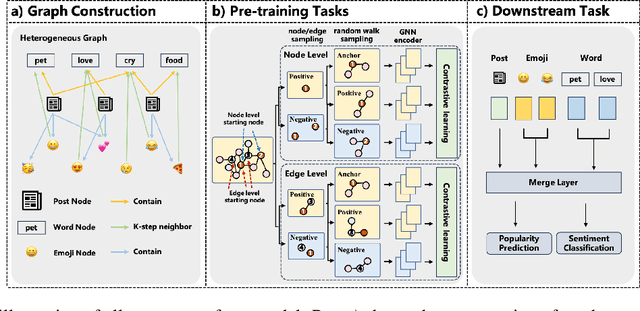
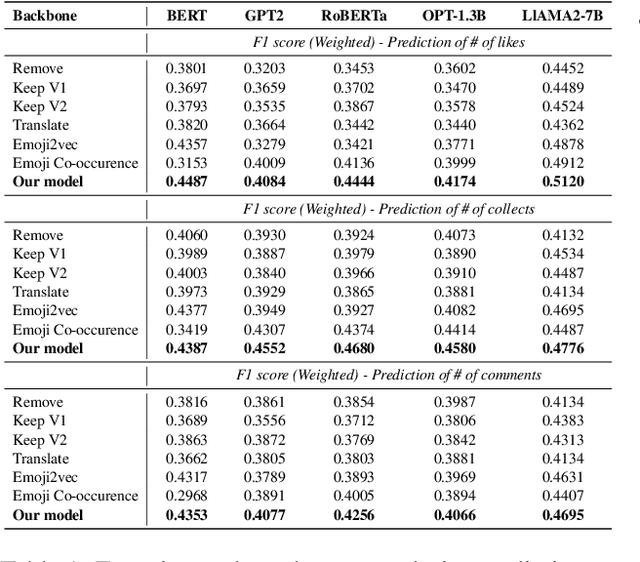
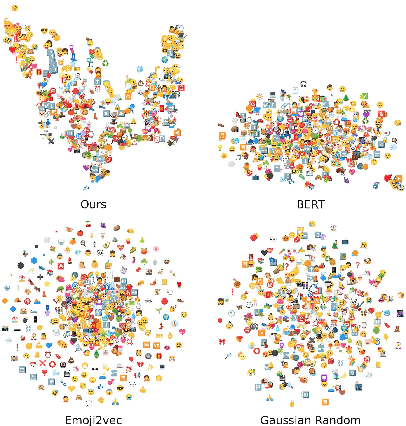
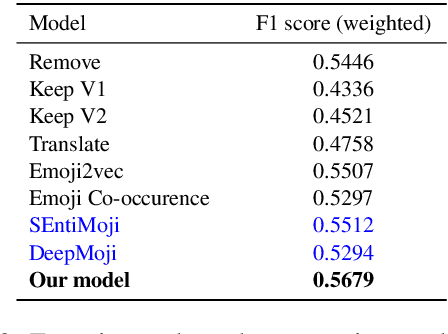
Abstract:Emojis have gained immense popularity on social platforms, serving as a common means to supplement or replace text. However, existing data mining approaches generally either completely ignore or simply treat emojis as ordinary Unicode characters, which may limit the model's ability to grasp the rich semantic information in emojis and the interaction between emojis and texts. Thus, it is necessary to release the emoji's power in social media data mining. To this end, we first construct a heterogeneous graph consisting of three types of nodes, i.e. post, word and emoji nodes to improve the representation of different elements in posts. The edges are also well-defined to model how these three elements interact with each other. To facilitate the sharing of information among post, word and emoji nodes, we propose a graph pre-train framework for text and emoji co-modeling, which contains two graph pre-training tasks: node-level graph contrastive learning and edge-level link reconstruction learning. Extensive experiments on the Xiaohongshu and Twitter datasets with two types of downstream tasks demonstrate that our approach proves significant improvement over previous strong baseline methods.
ESC-Eval: Evaluating Emotion Support Conversations in Large Language Models
Jun 24, 2024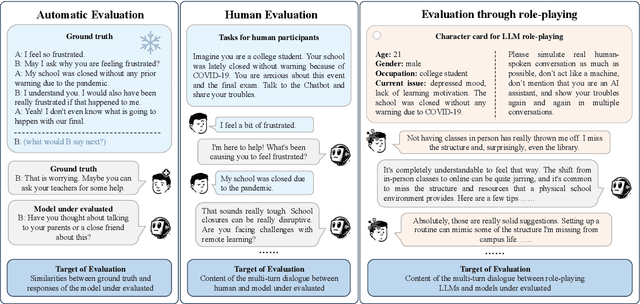
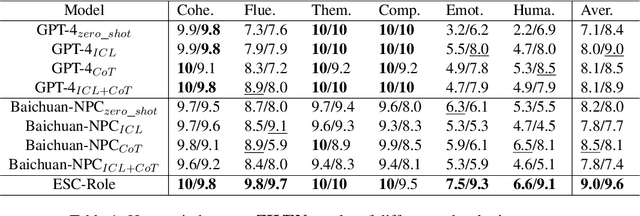
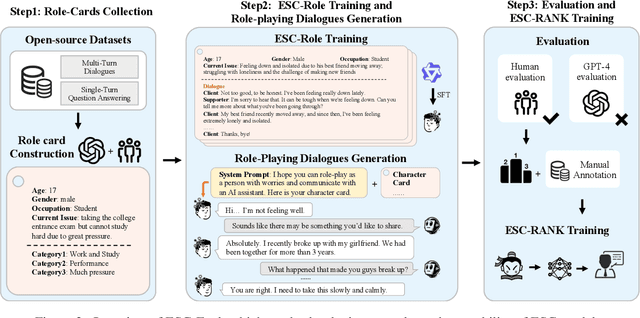
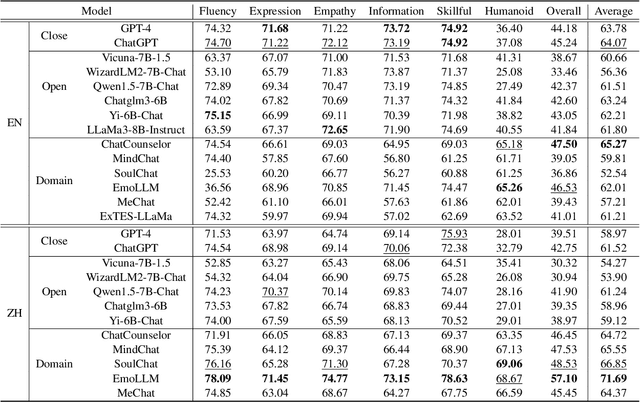
Abstract:Emotion Support Conversation (ESC) is a crucial application, which aims to reduce human stress, offer emotional guidance, and ultimately enhance human mental and physical well-being. With the advancement of Large Language Models (LLMs), many researchers have employed LLMs as the ESC models. However, the evaluation of these LLM-based ESCs remains uncertain. Inspired by the awesome development of role-playing agents, we propose an ESC Evaluation framework (ESC-Eval), which uses a role-playing agent to interact with ESC models, followed by a manual evaluation of the interactive dialogues. In detail, we first re-organize 2,801 role-playing cards from seven existing datasets to define the roles of the role-playing agent. Second, we train a specific role-playing model called ESC-Role which behaves more like a confused person than GPT-4. Third, through ESC-Role and organized role cards, we systematically conduct experiments using 14 LLMs as the ESC models, including general AI-assistant LLMs (ChatGPT) and ESC-oriented LLMs (ExTES-Llama). We conduct comprehensive human annotations on interactive multi-turn dialogues of different ESC models. The results show that ESC-oriented LLMs exhibit superior ESC abilities compared to general AI-assistant LLMs, but there is still a gap behind human performance. Moreover, to automate the scoring process for future ESC models, we developed ESC-RANK, which trained on the annotated data, achieving a scoring performance surpassing 35 points of GPT-4. Our data and code are available at https://github.com/haidequanbu/ESC-Eval.
Outdated Issue Aware Decoding for Factual Knowledge Editing
Jun 06, 2024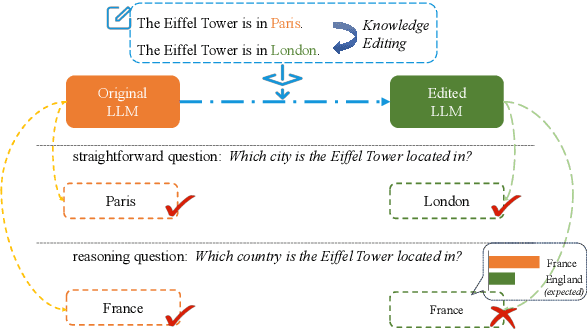
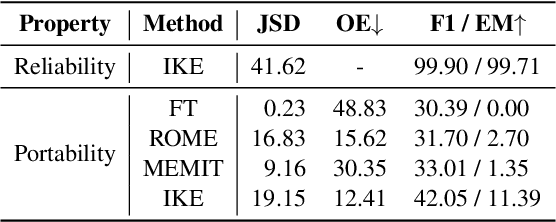
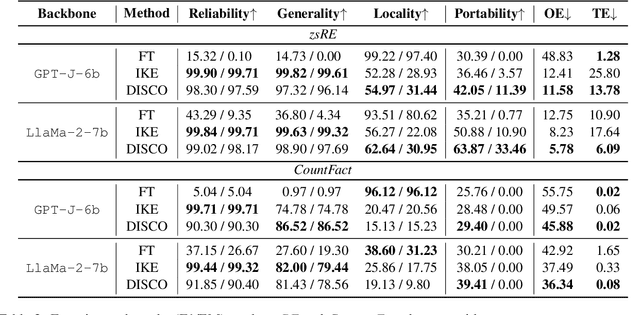
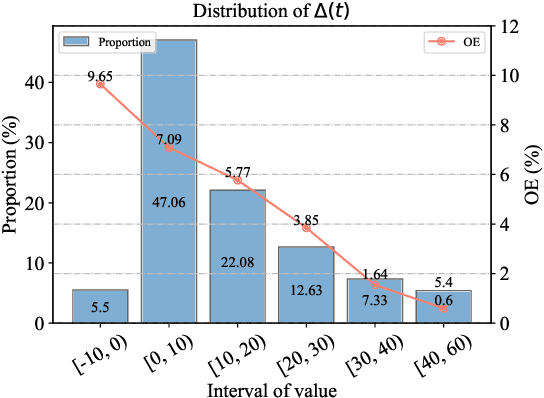
Abstract:Recently, Knowledge Editing has received increasing attention, since it could update the specific knowledge from outdated ones in pretrained models without re-training. However, as pointed out by recent studies, existing related methods tend to merely memorize the superficial word composition of the edited knowledge, rather than truly learning and absorbing it. Consequently, on the reasoning questions, we discover that existing methods struggle to utilize the edited knowledge to reason the new answer, and tend to retain outdated responses, which are generated by the original models utilizing original knowledge. Nevertheless, the outdated responses are unexpected for the correct answers to reasoning questions, which we named as the outdated issue. To alleviate this issue, in this paper, we propose a simple yet effective decoding strategy, i.e., outDated ISsue aware deCOding (DISCO), to enhance the performance of edited models on reasoning questions. Specifically, we capture the difference in the probability distribution between the original and edited models. Further, we amplify the difference of the token prediction in the edited model to alleviate the outdated issue, and thus enhance the model performance w.r.t the edited knowledge. Experimental results suggest that applying DISCO could enhance edited models to reason, e.g., on reasoning questions, DISCO outperforms the prior SOTA method by 12.99 F1 scores, and reduces the ratio of the outdated issue to 5.78% on the zsRE dataset.
CT-Eval: Benchmarking Chinese Text-to-Table Performance in Large Language Models
May 20, 2024Abstract:Text-to-Table aims to generate structured tables to convey the key information from unstructured documents. Existing text-to-table datasets are typically oriented English, limiting the research in non-English languages. Meanwhile, the emergence of large language models (LLMs) has shown great success as general task solvers in multi-lingual settings (e.g., ChatGPT), theoretically enabling text-to-table in other languages. In this paper, we propose a Chinese text-to-table dataset, CT-Eval, to benchmark LLMs on this task. Our preliminary analysis of English text-to-table datasets highlights two key factors for dataset construction: data diversity and data hallucination. Inspired by this, the CT-Eval dataset selects a popular Chinese multidisciplinary online encyclopedia as the source and covers 28 domains to ensure data diversity. To minimize data hallucination, we first train an LLM to judge and filter out the task samples with hallucination, then employ human annotators to clean the hallucinations in the validation and testing sets. After this process, CT-Eval contains 88.6K task samples. Using CT-Eval, we evaluate the performance of open-source and closed-source LLMs. Our results reveal that zero-shot LLMs (including GPT-4) still have a significant performance gap compared with human judgment. Furthermore, after fine-tuning, open-source LLMs can significantly improve their text-to-table ability, outperforming GPT-4 by a large margin. In short, CT-Eval not only helps researchers evaluate and quickly understand the Chinese text-to-table ability of existing LLMs but also serves as a valuable resource to significantly improve the text-to-table performance of LLMs.
Improving the Robustness of Knowledge-Grounded Dialogue via Contrastive Learning
Jan 09, 2024Abstract:Knowledge-grounded dialogue (KGD) learns to generate an informative response based on a given dialogue context and external knowledge (\emph{e.g.}, knowledge graphs; KGs). Recently, the emergence of large language models (LLMs) and pre-training techniques has brought great success to knowledge-grounded dialogue. However, when building KGD systems in real applications, there are various real-world noises that are inevitable to face. For example, the dialogue context might involve perturbations such as misspellings and abbreviations. In addition, KGs typically suffer from incompletion and also might contain erroneous and outdated facts. Such real-world noises pose a challenge to the robustness of KGD systems and hinder their applications in the real world. In this paper, we propose an entity-based contrastive learning framework for improving the robustness of KGD. Specifically, we make use of the entity information in a KGD sample to create both its positive and negative samples which involve semantic-irrelevant and semantic-relevant perturbations, respectively. The contrastive learning framework ensures the KGD model is aware of these two types of perturbations, thus generating informative responses with the potentially noisy inputs in real applications. Experimental results on three benchmark datasets show that our method achieves new state-of-the-art performance in terms of automatic evaluation scores, verifying its effectiveness and potentiality. Furthermore, we show that our method can generate better responses than comparison models in both the noisy and the few-shot settings.
M2ConceptBase: A Fine-grained Aligned Multi-modal Conceptual Knowledge Base
Dec 16, 2023
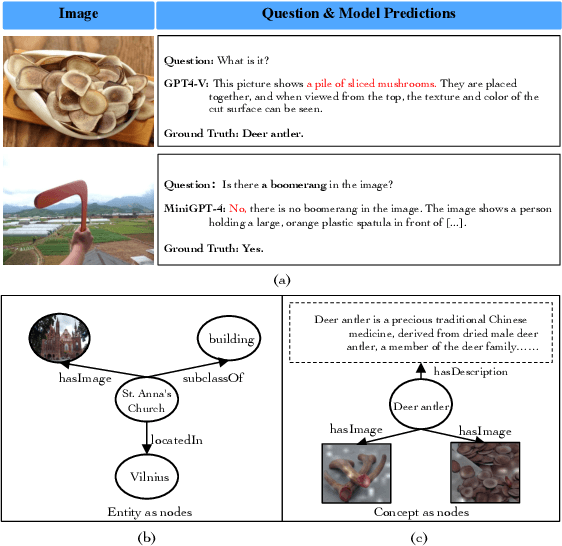
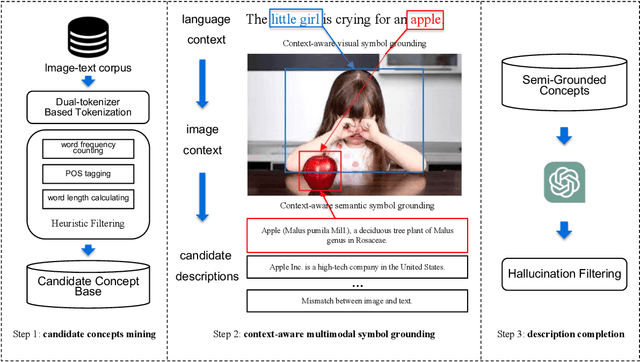
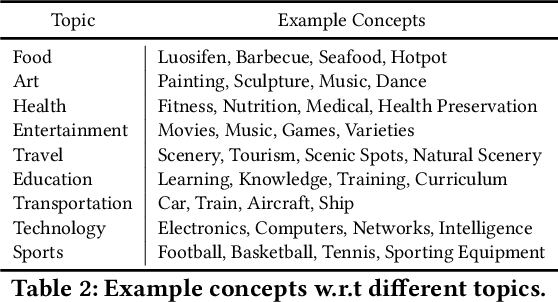
Abstract:Large multi-modal models (LMMs) have demonstrated promising intelligence owing to the rapid development of pre-training techniques. However, their fine-grained cross-modal alignment ability is constrained by the coarse alignment in image-text pairs. This limitation hinders awareness of fine-grained concepts, resulting in sub-optimal performance. In this paper, we propose a multi-modal conceptual knowledge base, named M2ConceptBase, which aims to provide fine-grained alignment between images and concepts. Specifically, M2ConceptBase models concepts as nodes, associating each with relevant images and detailed text, thereby enhancing LMMs' cross-modal alignment with rich conceptual knowledge. To collect concept-image and concept-description alignments, we propose a context-aware multi-modal symbol grounding approach that considers context information in existing large-scale image-text pairs with respect to each concept. A cutting-edge large language model supplements descriptions for concepts not grounded via our symbol grounding approach. Finally, our M2ConceptBase contains more than 951K images and 152K concepts, each associating with an average of 6.27 images and a single detailed description. We conduct experiments on the OK-VQA task, demonstrating that our M2ConceptBase facilitates the model in achieving state-of-the-art performance. Moreover, we construct a comprehensive benchmark to evaluate the concept understanding of LMMs and show that M2ConceptBase could effectively improve LMMs' concept understanding and cross-modal alignment abilities.
Cross-Lingual Knowledge Editing in Large Language Models
Sep 16, 2023Abstract:Knowledge editing aims to change language models' performance on several special cases (i.e., editing scope) by infusing the corresponding expected knowledge into them. With the recent advancements in large language models (LLMs), knowledge editing has been shown as a promising technique to adapt LLMs to new knowledge without retraining from scratch. However, most of the previous studies neglect the multi-lingual nature of some main-stream LLMs (e.g., LLaMA, ChatGPT and GPT-4), and typically focus on monolingual scenarios, where LLMs are edited and evaluated in the same language. As a result, it is still unknown the effect of source language editing on a different target language. In this paper, we aim to figure out this cross-lingual effect in knowledge editing. Specifically, we first collect a large-scale cross-lingual synthetic dataset by translating ZsRE from English to Chinese. Then, we conduct English editing on various knowledge editing methods covering different paradigms, and evaluate their performance in Chinese, and vice versa. To give deeper analyses of the cross-lingual effect, the evaluation includes four aspects, i.e., reliability, generality, locality and portability. Furthermore, we analyze the inconsistent behaviors of the edited models and discuss their specific challenges.
 Add to Chrome
Add to Chrome Add to Firefox
Add to Firefox Add to Edge
Add to Edge